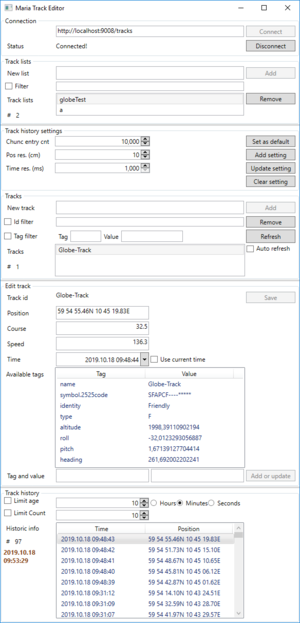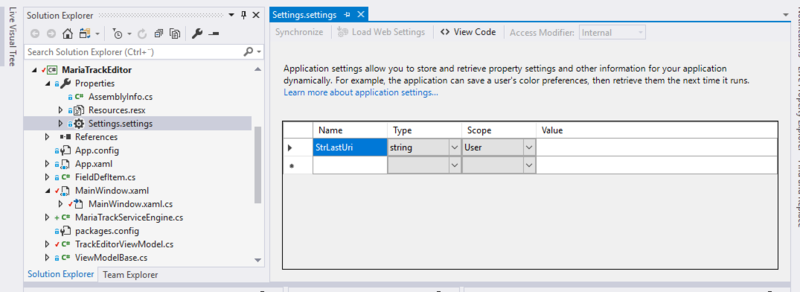Track Editor: Difference between revisions
Jump to navigation
Jump to search
No edit summary |
No edit summary |
||
| Line 1: | Line 1: | ||
[[File:trackserviceeditor.png|right|thumb | [[File:trackserviceeditor.png|right|300px|thumb|Maria track editor (WPF)]] | ||
This section describes how to create a WPF application interacting with a '''''Maria Track Service''''', without using '''''MariaUserControl''''' and track layer. | This section describes how to create a WPF application interacting with a '''''Maria Track Service''''', without using '''''MariaUserControl''''' and track layer. | ||
| Line 190: | Line 190: | ||
</source> | </source> | ||
Run your application, and verify that you can connect to your track service(s), and that the last successful service URI is used when restarting the application. | {{Note|Run your application, and verify that you can connect to your track service(s), and that the last successful service URI is used when restarting the application.|reminder}} | ||
=== Track list management === | === Track list management === | ||
Revision as of 15:54, 18 October 2019
This section describes how to create a WPF application interacting with a Maria Track Service, without using MariaUserControl and track layer.
General
This page is under construction!
- Note
-
- For general description of track related info, see General track service information.
- For this part you will need to include the TPG.Maria.TrackLayer NuGet package as a minimum.
- You also need to have a Track Service available.
- Sample code for this section is the MariaTrackEditor project, in the Sample Projects solution.
Start with creating a WPF App project!
Track service engine
The Track service engine encapsulates service interaction.
Available functions:
- Connection
-
- ConnectToTrackService
- Connect to specified track service.
- If URI is not given, endpoint info from configuration file will be used (if available).
- Binding type is assumed to be BasicHttp!
- For service configuration, see Basic map client, Service configuration
- Disconnect
- Disconnect from service
- IsConnected
- Get current connection status.
- Track lists
-
- GetTrackLists
- Retreive available tracklists from track service.
- AddTrackList
- Create a new track list.
- RemoveTrackList
- Remove track list, and all track info, if any.
- Tracks
-
- GetAllTracks
- Retreive available tracks from a specific track list, matching the search criteria.
- GetTrackData
- Retreive specified tracks from a specific track list.
- AddOrUpdateTrack
- Create or update specific track.
- Track history setting
-
- GetTrackHistoryOptions
- SetDefaultTrackHistoryOptions
- Set default track history options for new track lists.
- SetTrackHistoryOptions
- Retreive track history options for specified track list.
- Track history
-
- RemoveTrack
- Remove specified track from specific track list
- GetTrackHistory
- Retreive available track history information for specified track & track list, according to filter criteria.
Source code for MariaTrackServiceEngine
Track editor
Connection management
Connection features:
- Connect to track service
- Default track service from configuration
- Alternative track service
- Disconnect from service
- Show connection status
At startup, the Track Editor should try to connect to the latest track service successfully connected to.
To store the last value used, add a string value, StrLastUri to the project settings.
Add the following to your window xaml:
<GroupBox Header="Connection" >
<Grid >
<Grid.RowDefinitions>
<RowDefinition Height="auto"/>
<RowDefinition Height="auto"/>
</Grid.RowDefinitions>
<Grid.ColumnDefinitions>
<ColumnDefinition Width="100"/>
<ColumnDefinition Width="*"/>
<ColumnDefinition Width="100"/>
</Grid.ColumnDefinitions>
<Label Content="Service URI"/>
<TextBox Grid.Row="0" Grid.Column="1" Margin="2"
Text="{Binding ConnectionUri}"/>
<Button Grid.Row="0" Grid.Column="3" Height="22" Margin="2"
Content="Connect"
Command="{Binding ConnectCmd}" />
<Label Grid.Row="1" Grid.Column="0" Margin="2"
Content="Status"/>
<TextBlock Grid.Row="1" Grid.Column="1" Margin="2"
VerticalAlignment="Center"
Text="{Binding ConnectionStatus}"/>
<Button Grid.Row="1" Grid.Column="3" Height="22" Margin="2"
Content="Disconnect"
Command="{Binding DisconnectCmd}"/>
</Grid>
</GroupBox>
Then, add the following to your view model:
. . .
public ICommand ConnectCmd { get { return new DelegateCommand(Connect, CanConnect); } }
public ICommand DisconnectCmd { get { return new DelegateCommand(Disconnect, CanDisconnect); } }
. . .
private void Connect(object obj = null)
{
ConnectionStatus = "Connection requested ... ";
if (_trackServiceEngine.ConnectToTrackService(ref _connectionUri))
{
Settings.Default.StrLastUri = ConnectionUri;
Settings.Default.Save();
ConnectionStatus = "Connected!";
}
else
{
ConnectionStatus = "Not connected, connection failed! ";
if (string.IsNullOrWhiteSpace(ConnectionUri))
{
ConnectionStatus += "\nSupply URI - or correct 'system.serviceModel' configuration!";
}
}
RefreshConnectionInfo();
}
private bool CanConnect(object obj)
{
return !_trackServiceEngine.IsConnected();
}
private void Disconnect(object obj)
{
_trackServiceEngine.Disconnect();
ConnectionStatus = "Disconnected!";
}
private bool CanDisconnect(object obj)
{
return _trackServiceEngine.IsConnected();
}
. . .
public string ConnectionUri {
get { return _connectionUri; }
set
{
_connectionUri = value;
NotifyPropertyChanged(() => ConnectionUri);
}
}
public string ConnectionStatus
{
get { return _connectionStatus; }
set
{
_connectionStatus = value;
NotifyPropertyChanged(() => ConnectionStatus);
}
}
. . .
internal void RefreshConnectionInfo()
{
NotifyPropertyChanged(() => ConnectionStatus);
NotifyPropertyChanged(() => ConnectionUri);
}
. . .
Run your application, and verify that you can connect to your track service(s), and that the last successful service URI is used when restarting the application.
Track list management
Track list features:
- Display existing track lists
- Filter track lists.
- Add new track list
- Select track list
- Remove selected track list



